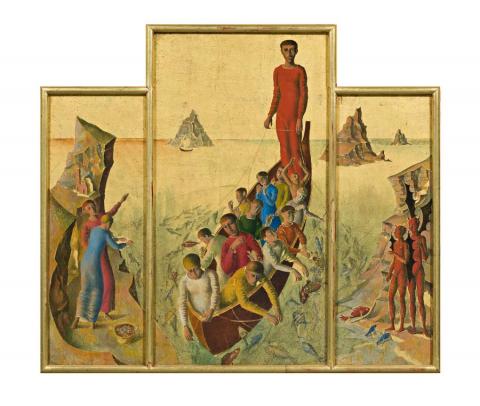THE MIRACULOUS DRAUGHT, c.1958 (also known as MIRACULOUS DRAUGHT OF FISHES)
JUSTIN O'BRIEN
oil over gold leaf on paper on hardboard
triptych: 41.5 x 47.5 cm overall
signed upper right of right panel: O'BRIEN
Commissioned by Geoffrey Ellsworth from the artist, c1958
Macquarie Galleries, Sydney (label attached verso)
Philip Bacon Galleries, Brisbane
Private collection, Brisbane
Waratah Spring Festival, Sydney, 4–11 October 1958, no. 29 (as 'The Immaculate [sic] Draught', from the private collection of Mr Geoffrey Ellsworth)
Justin O'Brien, Philip Bacon Galleries, Brisbane, 3–28 October 2006, no. 12
Justin O'Brien: The Sacred Music of Colour, Art Gallery of New South Wales, Sydney, 18 December 2010 – 27 February 2011, cat. 44
Bradley, A., The Art of Justin O'Brien, The Craftsman's Press, Sydney, 1982, fig. 29, pp. 26, 96, 106 (illus. p. 96)
Pearce B., and Wilson, N., Justin O'Brien: The Sacred Music of Colour, Art Gallery of New South Wales, Sydney, 2010, pp. 76, 77, 84–85, 158 (illus. pp. 84–85)
Miraculous Draught of the Fishes, c1958, watercolour, pen and ink, 39.8 x 47.4 cm overall, collection of the National Gallery of Australia, Canberra
The subject of the miraculous draught of fishes has long attracted artists from Medieval times through to the present. Works by Duccio, Raphael and Rubens are among the very memorable, together with that fascinating version painted by the fifteenth-century Swabian artist, Konrad Witz. These Gospel stories so appealed to Justin O'Brien that in 1978 he devoted half an exhibition to them.1 The Christian Gospels give us two stories of such miracles, the first relating to the calling of Saints Peter, James and John. The second comes after Christ's resurrection. O'Brien painted both versions. In our painting, Christ is shown tall, standing in the boat as his disciples haul in their miraculous catch. In the left panel, two apostles stand by the shore, one gesturing to the extraordinary event taking place. The disciples become 'fishers of men', the boat an ancient symbol of the Christian Church, as over all towers the hieratic figure of Christ, clad in the red of majesty.2 The right hand panel has the curiosity of two devils on the other shore, introducing a touch of the Last Judgment through O'Brien's creative imagination. In paintings of the Last Judgment, it was traditional to place the damned on Christ's left.
When O'Brien was awarded the inaugural Blake Prize for Religious Art in Sydney in 1951, he was formally recognized as one of Australia's leading religious painters. The prizewinning painting, The Virgin Enthroned, 1951, was acquired through the Felton Bequest by the National Gallery of Victoria, being greatly admired for its 'Byzantine' riches of colour and form.3 O'Brien had adopted the triptych, as in our painting, that three-panel format traditionally associated with religious art. The Miraculous Draught, c1958 with its gold leaf background shows the then creative influence on O'Brien of the painter, Duccio, whose work he had admired in Siena during earlier travels. 'It was in Siena', O'Brien said, 'where I first really had a proper aesthetic experience, the first time I really felt design and colours.'4 While Duccio and the art of his contemporaries derived from Byzantium, it was a time of restless change in Italy as Renaissance ideas began to break through the bonds of the later Middle Ages. O'Brien seized upon its liveliness and handling of space, engaging gilded surfaces to provide the perfect foil for his expressive feeling for line and sumptuous sense of colour. To The Miraculous Draught he added an idiosyncratic air of fantasy derived from religious mystery. In this and other works, O'Brien thereby brought the potency of the icon, the holy image, into the new world of contemporary art, full of aesthetic delights.
1. Macquarie Galleries, Sydney, 20 September - 9 October 1978
2. Matthew 4:19
3. In 1952 the Art Gallery of New South Wales purchased O'Brien's painting, The Last Supper followed by Supper at Emmaus in 1953.
4. Justin O'Brien, quoted in France, C., Justin O'Brien: Image and Icon, Craftsman House, Sydney, 1997, p. 17
DAVID THOMAS
